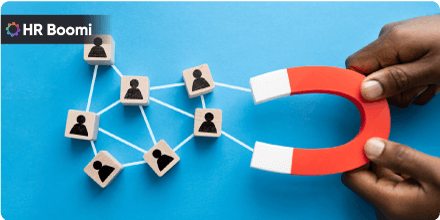
Table of Contents
In the modern, rapid-paced business landscape, Human Resource Management Systems have emerged as a basic resource for streamlining employee management. Those innovations have revolutionised HR experts’ functions and transformed the employee landscape. This article delves into four tremendous HR tech innovations redefining employee management.
With this technology, groups can gain a holistic view of their body of workers, improving efficiency, engagement, and productivity. According to the latest study by Deloitte, 68% of corporations think about the HR era necessary for his or her business achievement. Let’s explore how those improvements are reshaping the panorama of employee management, making sure it is a more strategic, data-driven, and worker-centric method.
Artificial Intelligence and Machine Learning in HR
Artificial Intelligence (AI) and Machine Learning (ML) rapidly transform the HR panorama. Those technologies can analyze hefty datasets to become aware of developments, styles, and insights that could be omitted with the help of HR professionals. Here’s how AI and ML are revolutionizing employee management:
Enhanced Recruitment and Selection
AI-driven algorithms have revolutionized the recruitment method by extensively improving the efficiency and accuracy of candidate selection. Those algorithms can preciously go through countless resumes and job applications, carefully studying the information and qualifications of each candidate. This procedure is sometimes quick but also astoundingly thorough, ensuring that every relevant aspect of a candidate’s profile is considered.
By comparing the competencies, qualifications, and requirements mentioned in resumes with the precise job necessities and outlines, AI-driven algorithms can correctly recognize the candidates whose profiles align carefully with the position’s conditions. This now saves precious time for HR specialists and ensures that the right applicants, the best suited for the function, are identified with a level of precision that is often tough to gain through conventional manual screening strategies. As a result, agencies could make more knowledgeable and statistically driven hiring selections, ultimately leading to higher matches among candidates and available positions.
Predictive Analytics
HR teams are increasingly harnessing the potential of AI and ML to expect and reduce worker turnover. Analyzing large data and considering multiple essential factors, including worker satisfaction and performance, AI systems can provide early warnings of probable resignations.
By figuring out patterns and trends in worker behaviour that technology provides, HR professionals can take proactive measures to maintain valuable intelligence. This predictive technique permits businesses to enforce employee retention techniques, such as tailored improvement plans or advanced work situations, thereby lowering turnover rates and fostering a strong and engaged body of workers.
Employee Engagement
AI-powered chatbots and digital assistants have emerged as crucial equipment in improving company worker engagement and support. Those intelligent virtual assistants are to be had across the clock to deal with employee queries, offer statistics, and provide real-time help while retaining a regular and pleasant interaction pattern.
This now not only boosts worker satisfaction via imparting quick and convenient access to integral statistics but also helps in additionally lightening the HR team’s workload. Through automating ordinary inquiries and tasks, HR specialists can become conscious of their solution on more complicated and strategic subjects, in the long run enhancing overall efficiency and service in the company.
Learning and Development
AI is revolutionizing employee training and development by tailoring packages to personnel needs and overall performance information. This dynamic method guarantees that personnel get hold of exactly the training they require at the right moments of their careers.
By analyzing performance information, AI can perceive skill gaps and endorse or provide focused knowledge of data, courses, or education, increasing the effectiveness of the training system. This fosters non-stop skill development and bolsters worker engagement and work satisfaction as they get special opportunities that align with their professional aspirations and the organization’s goals.
Reference Link: Harvard Business Review
Cloud-Based HR Management Systems
Cloud-based Human Resource Management Systems (HRMS) have become a cornerstone of modern-day employee management, streamlining and optimizing HR operations. Those structures provide a centralized and effortlessly available platform for HR obligations and statistics, irrespective of surrounding area, as long as a web connection exists.
There are many benefits, including improved flexibility, remote accessibility, and the removal of the need for vast physical infrastructure. This not only makes HR approaches more efficient; but also guarantees information safety through robust backup and security measures, making it a powerful and scalable solution for agencies of all sizes.
Remote Accessibility
In remote work technology, cloud-based HR systems are a linchpin for effective HR management. These systems empower HR specialists to access quintessential information requests seamlessly and conduct open conversations with employees from anywhere. Whether operating domestically, in a specific workplace, or even on the go, cloud-based HRMS ensures that HR responsibilities are fulfilled effortlessly, enabling HR teams to evolve to the flexible needs of the current team of workers, fostering effective remote work capabilities, and preserving seamless employee help and engagement.
Data Security
Cloud-based systems are acknowledged for their strong security measures, which are essential in safeguarding sensitive worker information. These systems typically consist of layers of safety, including encryption, authentication protocols, and access controls, to protect against unauthorised admissions. Moreover, common updates and record backups are modern practices within cloud-based structures, ensuring that the data’s integrity is maintained while minimizing the risk of data breaches or loss.
This commitment to safety no longer solely instils trust in personnel and stakeholders but also guarantees compliance with data security guidelines, making cloud-based HRMS an error-proof and reliable source for managing HR statistics.
Cost-Effective
Cloud-based HR systems provide considerable cost reduction by decreasing the reliance on physical infrastructure and renovation. Without needing on-premises servers and dedicated IT staff to maintain them, businesses of all sizes can substantially cut down their IT expenditure.
Moreover, cloud-based systems provide scalable answers, permitting corporations to pay just for the subscriptions and assets they use, which makes it a cost-effective choice for each small and huge organizations. This cost effectiveness frees up assets that may be allocated to different strategic initiatives, boosting the employer’s economic stability and other aspects in the long run.
Scalability
Cloud-based HRMS stands out for its tremendous scalability, accommodating an organization’s economic success or adjustments seamlessly. This flexibility is a key advantage, as it lets corporations easily enlarge their HR infrastructure, adding new functions or accommodating a developing group of workers besides the need for extra tools.
Conversely, while corporations want to downsize or restructure, cloud-based systems can quickly adjust to match their evolving HR wishes. This ensures that HR department stays aligned with the organization’s converting necessities. This flexibility, provided by cloud-based solutions, fosters agility and value effectiveness, making them an ideal preference for corporations navigating a dynamic and evolving landscape.
Employee Self-Service Portals
Employee self-service portals are at the forefront of modifying the employee-HR dynamic. Those online systems empower personnel by letting them independently deal with diverse HR-associated obligations such as updating personal statistics, filing time-off requests, and gaining access to important information.
By shifting those obligations to personnel, HR departments lessen their administrative workload drastically, permitting HR professionals to pay attention to more strategic and cost-effective activities. This streamlines HR operations and fosters additional employee freedom and engagement, as individuals directly control their HR interactions. In the long run, it creates an extra efficient and fulfilling employee experience.
Time and Attendance Management
Employee self-service portals provides a benefit of simplifying time management for personnel and HR groups. Employees can effectively log their hours, request days off, and get the right to enter their attendance data through these structures. This streamlined procedure now enhances transparency and accuracy and empowers employees to take control of their time-associated tasks, reducing the administrative burden on HR experts.
Therefore, HR departments can allocate their time and resources more efficaciously, focusing on strategic tasks while presenting employees with the equipment they need for powerful time management. This collaborative technique ultimately contributes to enhanced staff productivity and pleasure.
Benefits Administration
Self-service portals create more benefits by permitting employees to control their HR-related tasks effectively. Employees could make personal well-being, ensuring that they align with their goals. These portals also facilitate brief updates to non-public data, decreasing administrative burdens on HR departments. Furthermore, personnel can independently access essential information like pay slips and tax system, improving transparency and accessibility.
This empowerment streamlines HR operations and enhances worker engagement by providing convenient and personalized information over crucial HR obligations, contributing to an additional efficient and enjoyable environment.
Performance Evaluation
Employee self-service portals go beyond administrative obligations to empower personnel. These portals permit employees to monitor their performance, self-determine their progress, and get comments from supervisors. This self-driven performance management method promotes employee engagement, as people can actively participate in placing and monitoring their objectives, leading to extended accountability and personal development.
Supervisors have an advantage as they can provide timely feedback and regulate worker progress through a handy virtual platform, streamlining the performance appraisal manner and fostering a greater collaborative and success-orientated environment.
Training and Development
Worker self-service portals promotes a system of continuous learning by presenting admission to training and development. Employees can explore education sources that align with their skill improvement goals. This accessibility of getting to know possibilities now encourages private growth and skills enhancement and contributes to a workforce better equipped to meet the evolving needs of the company and the broader industry.
As a result, self-service portals end up as an integral catalyst for fostering a subculture of non-stop learning and adaptability in the workplace, benefitting each personnel and the agency as a whole in the long run.
People Analytics
People Analytics is revolutionising employee management by leveraging facts and evaluation to notify HR specialists. It systematically collects and interprets records across the worker lifecycle, from recruitment and onboarding to performance management and retention. By mining these facts, HR specialists gain invaluable insights into personnel tendencies, supporting them in making data-driven choices that optimize talent acquisition, improvement, and engagement.
This technique now not only complements HR’s strategic function in the enterprise but additionally results in extra effective employee management, in the end fostering a place of business wherein employees are better aligned with organizational dreams and business achievement.
Recruitment Optimization
People Analytics is revolutionizing employee management by leveraging facts and evaluation to tell HR selections. It systematically collects and interprets records across the worker lifecycle, from recruitment and onboarding to performance management and retention.
By mining these facts, HR specialists gain invaluable insights into personnel tendencies, supporting them in making data-driven choices that optimize talent acquisition, improvement, and engagement. This technique now not only complements HR’s strategic function in the enterprise but additionally results in extra effective employee management, in the end fostering a place of business wherein humans are better aligned with organizational dreams and business achievement.
Employee Productivity
People Analytics is pivotal in employee management to identify key factors affecting employee productivity. Through systematic records interpretation, organizations can uncover overall performance-influencing factors of employees, training needs, or personal strengths and weaknesses. With these insights, HR professionals can implement specific steps to enhance worker performance.
Whether or not it’s streamlining processes, providing unique training, or customized support, data-driven interventions help create a more effective body of workers. This improves employee performance and contributes to organizational achievements by aligning employees with the employer’s strategic goals.
Diversity and Inclusion
People Analytics is an ideal tool for promoting diversity and inclusion inside the administrative centre. By analyzing data associated with numerous components of the worker lifecycle, including recruitment, promotion, and retention, agencies can gain essential insights into their diverse lamdscape. These insights permit HR experts to recognise disparities and regions where diversity and inclusion can be implemented.
Armed with this information, businesses can implement focused approach, rules, and tasks to create an extra inclusive and unbiased surrounding, reaping the rewards not solely for the employees but for the company’s recognition, innovation, and long-term achievement. In this method, People Analytics not only promotes diversity and inclusion but also aligns the workplace with evolving societal values and expectations.
Succession Planning
People Analytics is crucial in succession planning, ensuring that organisations have a pool of certified applicants to step into vital roles when wanted. HR experts can pick out high-potential personnel through this data-driven technique, examine their skills and desires, and create dedicated development plans.
This strategic process minimises the risk of leadership gaps. It promotes organisational stability, as there are well-organized successors available to step into key positions, safeguarding the continuity and long-term fulfilment of the corporation in the end. Succession planning, driven via people analytics, becomes a proactive approach that fosters talent improvement and helps leadership growth within the enterprise.
Conclusion
In an ever-evolving business world, staying on the cutting edge of the HR era is integral for effective employee management. The innovations mentioned above – artificial intelligence getting to know, Cloud-based HR management systems, Employee Self-Service Portals, and Analytics – offer a holistic view of the workforce, making HR techniques excellent, data-driven, and employee-centric.
As companies continue to undertake these innovations, they will enhance their HR competencies and improve employee engagement, satisfaction, and retention. By investing in these technologies, agencies can navigate the complexities of modern employee management with more ease and agility.
The HR panorama is evolving, and those who embrace these improvements could be better positioned to draw, develop, and retain top talent, ultimately managing their business success in a more aggressive marketplace.
Recent Posts
-

In-house vs. Outsourced Payroll: Pros and Cons
-

Mastering Talent Retention: A Corporate Challenge
-

What is employer branding and how to apply it in your company?
-

The Significance of Employee Communication Within
-

What is time management and why is it important?
-

Net salary: what is it and how is it calculated?
-

Enhancing Employee Experience: Strategies for Excellence
-

10 Best Gifts to Boost Sales Channels
